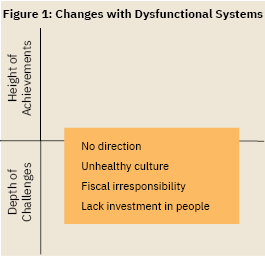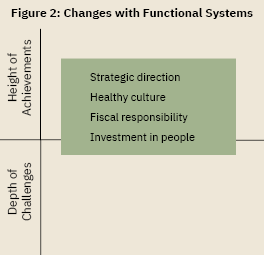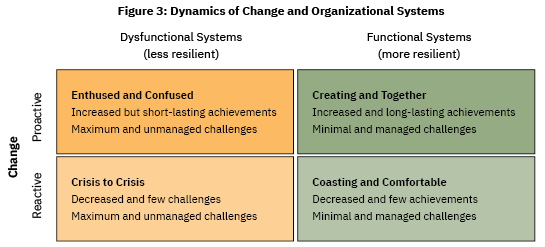By Corky McReynolds, PhD, CPF
LeadTeamConsulting.com
click here to read as a printable pdf (300kb)
After drastic and negative organizational change, a leader of a nonprofit recently exclaimed to me that they wished the organization could get past this crisis and get back to doing the mission. The leadership team was exhausted from the on-going battle with the issue and its impact. After a major change, leaders, board members, and staff seek a few moments of organizational peace when everyone is working together, the finances are good, and the programs are working. Leaders seek a day at work when there are no crises, no irritating challenges, or no crazy interruptions that could signal impending issues. Leaders seek a stretch of calm water after navigating turbulent rapids. Peter Vaill (1989) uses an analogy that organizations are in constant whitewater, that there is no calm water, and that organizations should be prepared to continually navigate the challenges and changes of that whitewater.
Why do some organizations endure, or even prosper, during change? Why do some organizations recover from major change in less time than others, or recover to become stronger than they were before?
"Change is the process by which the future invades our lives."
Alvin Toffler
The great news is that the more we are prepared to read the river and paddle its course, any negative impact of change will be shorter, while the positive impact of change will be greater. We can actually have fun along the way! If we understand that change is constant and we have core functional systems in place for change to occur, then organizations will be less impacted by negative changes. Negative impacts of change that are beyond our control can be mitigated with functional systems in place. With functional systems in place, the changes we institute to improve our organizations will have a better chance of success.
The challenge of change is not about the change itself but rather the resiliency of the organization during change. Resiliency is the ability for an organization to endure and succeed during and after a change occurs. Core systems effect an organization’s resiliency. This paper describes four core systems and the impact each of these systems can have on either building or hindering resiliency. A model is proposed that identifies and illustrates the relationship among functional or dysfunctional systems with resiliency, achievement, and challenges.
The impact of change is reflected in an organization’s leadership, culture, and core functional systems working together for success. What are core functional systems and how are they related to the change process?
FUNCTIONAL SYSTEMS BUILD RESILIENCY
The processes that we use to create, direct, manage, evaluate, and renew organizations include four core functional systems.
Setting strategic direction and striving to reach a mission is usually created through strategic planning and mindful implementation. Organization’s create direction, and to be functional, action for implementation. A functional strategic plan serves as a guide with priorities and focus. A strategic plan provides the reason to be proactive for change and to be prepared when external influences change.
An Executive Director shared their strategic plan with pride. I was asked to comment and relied, where are the priorities? The Executive Director replied they are all priorities. OK, I said, Where do you start? The response was, “We are supposed to start them all now.”
Another organization asked me if the plan from 1998 needed updating.
And yet another claimed they had a strategic plan but could not locate it and staff were unaware that one existed.
Until the strategic plan has established priorities then it remains non-functional. As a functional system a strategic plan is not just implemented but truly integrated into an organization’s operational budget, staff goals, and governance responsibilities. Having and implementing a strategic plan is a functional system.
Creating a healthy culture is represented not only by stated values and beliefs (guiding principles), but also must be reflected through behaviors. Guiding principles must be experienced by those within the organization and stakeholders to be a functioning system. Stated organizational values that are not experienced by staff or stakeholders does not represent a functional system. The core values must be experienced.
During an organizational evaluation the assessment included a review and observation of its values. This author, as evaluator, arrived incognito the day before the scheduled meetings and portrayed a regular drop in visitor. A stated value was that people are greeted as they enter the building, but the evaluator entered the building without any direct contact from staff, and in fact one or two staff passed by without any greeting. The value was stated but did not represent the real culture.
When guiding principles are realized then a healthy culture follows, and the culture represents a functional system. “Organizational culture eats organizational change for breakfast, lunch, and dinner so don’t leave it unattended” (Rick, 2016).
Practicing fiscal responsibility through sound budgeting, developing sustainable revenues, fund-raising, and careful stewardship of resources establishes our fiscal health. Creating a budget based on a strategic plan helps create a functional system. Budgeting that is not integrated with a strategic plan is going to be less functional to change.
An organization has been running a negative annual budget and using reserves to balance the budget. This has worked for years but due to unanticipated changes, expenses have dramatically increased, and the reserves can no longer be relied on to balance the budget. The organization is constantly having to react and must quickly look for short- and long-term strategies to obtain fiscal sustainability.
Demonstrating fiscal responsibility requires all to be fully knowledgeable and can actually understand the budgeting process and financial reports.
Investing in people is directed attention and resources to building the capacity of staff, boards, and volunteers to accomplish a mission. Investing in people at all levels and roles in an organization is another functional system needed for change to be successful. If a nonprofit, board development is critical which includes careful selection of board members with a strong and purposeful orientation. Following best practices for boards or advisory committees contribute to a functional system. Providing staff development opportunities that are directly linked to the organization’s strategic direction and establishing individual annual work plans integrated with the strategic plan build a functional system.
A professional association board asked for team training. Why is this important now? The board replied they wanted to work better together. Why is this important? The board replied, well, the former treasurer still has the checkbook and won’t give it back. Rather than team training I suggested the associations president and current treasurer go to the former treasurer’s home and retrieve the checkbook. The assumption was if the former treasurer attended a team workshop, they would see the light and give the checkbook to the current treasurer.
Investment in people to create a functional system must be strategic and purposeful.
While this is not intended to be an exhaustive list of all organizational systems, these four core systems provide a strong framework for building resiliency during change.
Core systems and the degree that each of these systems is functional, represent the organization’s health or resilient capabilities during change. If organizations are at a loss to their strategic direction or lacking a clear plan and implementation strategy, then they are far less resilient when change happens. The same lack of resiliency can occur if any of the other systems are dysfunctional. Resiliency will be impacted by either type of change; that which is initiated by, or happens to, the organization. Recovery from change takes longer in organizations without core functional systems. Sometimes change is needed to regain or replace a dysfunctional system. This is referred as incremental change, which is necessary before fundamental or deep change can succeed across the organization (Quinn, 1996).
CHANGE WITH DYSFUNCTIONAL SYSTEMS
- A major opportunity lost when there is no focus to guide evaluation, priority, acceptance, or place in the current organization. (No direction).
- There is a need for program evaluation and improvements, but tradition creates barriers for progress. (Unhealthy culture).
- Unforeseen severe debt or lack of funds that threaten day to day operations and meeting the payroll. (Fiscal irresponsibility).
- Loss of long-time single source of funding without a back-up plan or contingency source. (Fiscal irresponsibility).
- Sudden leadership departure, for any reason, at the key administrative or other leadership level without a succession plan in place. (Lacking investment in people).
The impact of change with the lack of functional systems will result in a less resilient organization. Sometimes an organization tolerates a dysfunctional system and that also results in less resilient capabilities. Change with dysfunctional systems results in few and short and/or long-term achievements, while the challenges or negative impacts will be greater. Time to recover will take longer. (Figure 1).

When a nonprofit without a budget (although it did have a detailed accounting system) needed a major change to cover losses, it hit the organization hard. The organization is still trying to recover so its achievements are few and less significant. Another organization had a dysfunctional and negative culture and when a major change in leadership occurred, the resiliency of the organization was weak, challenges were deep, and recovery long. Another organization lacked a strategic plan and when confronted with major change it remained stagnant and unresponsive to community needs, resulting in fewer achievements.
In each of these cases the achievements were fewer while the challenges and negative impacts were greater. The lack of functional systems caused each organization to react to change rather than prepare, adapt, and be proactive to change.
CHANGE WITH FUNCTIONAL SYSTEMS
Functional systems become the strength-builders that potentially shorten the negative impact and recovery of change. Healthy, functional systems embrace change, make change, and manage change. The results are a resilient organization with greater, long-lasting achievements and less impact from challenges.

All systems, dysfunctional and functional, will also change; in fact, they need to change. All of the core systems, whether they are functional or dysfunctional are interrelated and impact each other.
An organization with an unhealthy culture that tried to change the dysfunctional system of fiscal irresponsibility without considering the impact and reactions experienced a significant decline. The depth of challenges has affected the nature of the organization. The impact has been severe, but by proactively working to change the dysfunctional into functional systems, the organization has begun recovery rather than continuing decline. The organization is becoming resilient by building a positive culture, improving communications, and implementing strategic priorities. By focusing on improving all of its core systems, it is achieving positive impact to fulfill its mission.
Any organization ignoring the need to change its systems will remain negatively impacted by any change it faces or tries to initiate. Positive change requires the integration of each of the core functional systems.
THE DYNAMICS OF CHANGE AND ORGANIZATIONAL SYSTEMS
Functional organizational systems build resiliency for two types of change. First, it enables an organization to better respond or react to negative or challenging change that happens to our organizations, even if the change is beyond our control. The second is to anticipate and be better prepared when change is needed and to be proactive to initiate desired change.
The Dynamics of Change and Organizational Systems (Figure 3) illustrates the resiliency among two types of response to change (Reactive and Proactive) with the degree of health of its core systems (Dysfunctional and Functional).

The “Achieving and Together” organization consists of functional systems which can be proactive to change. This organization is both achieving and resilient. The whitewater challenges are manageable, even exhilarating, because of the confidence in its systems and approaches.
A professional association has a strong and successful history of strategic planning and implementation. Board, staff and other members all join to create and become involved in working the plan. The association builds biannual and creative methods to engage members at its conference. This input is integrated into creating and revising the plan. Fiscal responsibility is strong by exercising strategic use of funds, enhancing its endowment, and successful fund raising. The association’s culture is strong, supportive, open and helpful to members and non-members. Investing in people is a functional system represented by intentional board development, member mentoring, scholarships, and peer assistance.
The “Coasting and Comfortable” organization may be resting on its reputation rather than its current productivity. Although it may be very subtle, when coasting it is either going downhill or slowing down, thus giving a false impression of safety, when dangerous whitewater might be just around the next bend.
This agency organization is proud of its traditions and programs. Staff have long tenures but have not challenged themselves to grow in the profession. They are absent from peer national conferences. The program brochure looks the same as from ten years ago. The observer’s experience when visiting is not negative, or is it positive, it is just there. There are well maintained exhibits, but no changes have been made in two decades. The organization’s image is high among the few people who care about its future.
A “Crisis to Crisis” organization is impacted by change and has little control of change. The organization is frequently battling with external influences of change and does not have the capacity to initiate and sustain change it seeks. The whitewater is close to capsizing the raft.
This small non-profit constantly struggles. Although it does have a strategic plan, due to limited human resources the Executive Director turns attention to putting out fires, teaches a wide variety of programs and ages, manages the land and sometimes cleans the bathrooms. All of these chores and responsibilities are real to all similar organizations but at some point, attention has to be diverted to higher level tasks to bring the nonprofit out of the current reactive state. (McReynolds, 2007).
The “Enthused and Confused” organization manages achievements through sheer determination and enthusiasm but is ill prepared for long-term impact of change. The whitewater experience is a ‘go for it’ attitude but the long-lasting achievement of rafting the big rapids may not be possible.
This professional association exists on the pure enthusiasm of its cause and dedication to mission. Excited young professionals adopt roles and responsibilities but have difficulty following through. Grants are easy to receive, and a strategic plan exists, but the group continues to wander off into something new and attainable rather than focusing on building sustainability. Major external policy changes beyond the organizations influence have caused rapid change that the group has been unprepared and remains a challenge.
PERSONAL IMPACT AND ROLE
An individual’s core values and principles affect our perspective and ability to change. “People can’t live with change if there’s not a changeless core inside them. The key to the ability to change is a changeless sense of who you are, what you are about, and what you value” (Covey, 2004, 108). Change is viewed differently by individuals. People either make, accept, or resist the change process. According to psychological preferences ,there are types who embrace change and become its agents and those who abhor change and become its resisters (Myers, 2015).
Resistance to change is inherently linked to an individual’s perspective and the culture of an organization. “Resistance to change… it is almost always from threats to traditional norms and ways of doing things. Often these norms are woven into the fabric of established power relationships” (Senge 1990, 88).
The concept of selfish and social power can provide some insights as to how some individuals view change. People focused on selfish power will use the change process to gain personal power, while those focused on social power will view the same change process as an opportunity to increase resources for others (McReynolds, 2019).
There are two types of change we face; change that happens to us, and change we initiate. Change is not one-dimensional, or just about trying to manage a crisis. “Things must get bad enough, or people will not change in any fundamental way. This leads to the mistaken belief that change requires a threat to survival. This crisis theory of change is…a dangerous over- simplification” (Senge, 1990, 154). Both the change process and the outcomes should be a positive force that results in individual growth and organizational success.
"People don’t resist change;
people resist being changed."
(Senge, 1990)
Models for change have been developed to help understand an individual’s perspective and engagement with organizational change. Many models resemble the typical grieving process. One example, The Change Cycle, includes six stages: Loss, Doubt, Discomfort, Discovery, Understanding, and Integration (CCMC, 2009).
What is the role of the leader in relationship to the individual and to the change process?
Leaders need to understand that everybody views the impact of change differently which requires preparation and open communication. Assess your organizations core systems. Which one may indicate dysfunction? Determine which core system is your strength then build resiliency from that core system to positively influence any of the dysfunctional systems.
Sometimes preparing people for organizational change can be simple. Be transparent, engage, inform, explain, empower.
Personal resiliency during the challenge of change might be based on a comparable set of core systems similar to the organization. On a personal level is our core systems represented by Emotional, Social, Spiritual and Physical health? If so, which of these systems are functional and which may be dysfunctional? Applying a similar assessment process, one can determine strengths that can used to build and positively influence your weaker systems.
From a large agency department, the hardest part of change is lack of control and influence. Staff interviewed stated, “It is not just about what is changing, but why. Just let us know, just let us have input.”
During a long career of mentoring and coaching sessions a common frustration among professionals wanting change to occur, but not having the status to make change, results in personal disengagement. At some point a personal decision needs to take place. Do you accept the change or lack of change? If yes, then it truly must be embraced with respective behaviors. If the change or lack of change cannot be accepted, then you need to leave that organization. Remaining without accepting the change will negatively impact your personal core systems.
OVERCOMING THE CHALLENGE OF CHANGE
The act of change challenges our systems. Using Peter Vaill’s analogy, the whitewater represents what is under the surface. There are eddies, swirls, chutes, invisible rocks, and other river features that represent organizational systems that keep changing. We change systems to remain functional for change. If we do not remain proactive toward the change needed for organizational systems, those systems can become dysfunctional. Even the best practices will also change to keep up with the ways we pursue an organization's mission.
Functional systems help manage change through their interrelationships and synergy. All the core functional systems working seamlessly can guide, manage, and help change succeed. If we can read the river to anticipate change needed, then we can act on that change.
An organization and its core functional systems are in constant motion. The more attention to building capacity for change through functional systems, the more positive impact that can be achieved with less stressful challenges. Are you personally ready for change? Are your organizational core systems functional and ready for change? The great news is we have a wealth of experience, best practices, mentors, and models to develop and enhance core systems to be functional for healthy organizations.
We can do better than just endure change. If we understand and prepare for change then we can embrace and prosper with change. We can celebrate greater achievements and fewer negative challenges. Prepare yourself and your organization with the skills and equipment to enter the whitewater. Enjoy the ride!
Corky McReynolds has a 45-year career as a director, professor, researcher, and consultant. He currently serves as founder and president of LeadTeam, a capacity building consultancy. He also teaches at Portland State University as adjunct faculty and serves as Senior Fellow at the Center for Public Service. Corky has been involved with ANCA since 1990.
The author is developing a tool that will aid organizations in assessing core systems and type and may be reached at
The author thanks Dr. Jim Goodrich, Dean, College of Business, Pacific University and John DeFillipo, Executive Director, JBS wetland Center for reviewing this article.
RESOURCES
Attong, M. (2013). Change or Die: The Business Process Improvements Manual. Boca Raton, FL: CRC Press.
Beckard, R.; Prichard, W. (1992). Changing the Essence. San Francisco: Josey-Bass.
Conner, D. (2006). Managing at the Speed of Change. NY: Random House.
Courtney, F. (2016). Six steps to Effective Organizational Change Management. (Blog). Pulselearning.com/blog/6-steps
Covey, S. (2004). Seven Habits of Highly Effective People. NY: Free Press.
Drucker, P. (1990). Managing the Nonprofit Organization. NY: Harper-Collins.
Ingles, M.; Morgan, D.; Shinn, C. (2019). New Public Leadership. NY: Rutledge.
Jacobs, R. (1997). Real Time Strategic Change. NY: John Wiley & Sons.
Kirby, L.; Myers, K. (2015). Introduction to Type. 7th Ed. SF: CPP.
Kouzes, J; Posner, B. (2007). The Leadership Challenge. SF: John Wiley & Sons.
Kotter, J. (2012). Leading Change. Boston: Harvard Business Publishing.
Marques, J.; Dhiman, S. (2017). Leadership Today. Switzerland: Springer.
McReynolds, C. (2017). Thinking Sideways for Effective Leaders. For Non-Profit Association of Oregon Workshops.
McReynolds, C. (2019). The Good Side of Power. Directions. Spring 2019. Logan, UT: Association of Nature Center Administrators.
Pasmore, W. (1994). Creating Strategic Change. NY: John Wiley & Sons.
Quinn, R. (2000). Change The World. SF: Josey-Bass.
Quinn, R. (1996). Deep Change. SF: Josey-Bass.
Schein, E. Organizational Culture and Leadership 5th Ed. Hoboken, NJ: John Wiley & Sons.
Senge, P. (1990). The Fifth Discipline. NY: Currency.
Stone, M.; Barlow, Z. (2011). Seven Lessons for Leaders in Systems Change. (Blog). www.Ecoliteracy.org/article/seven-lessons-systems-change. CA: Center for Ecoliteracy.
Toffler, A. (1970). Future Shock. NY: Random House.
Torben, R. (2016). Change (Blog). www.torbenrick.eu/blog/change
Vaill, P. (1989). Managing as a Performing Art. SF: Josey-Bass.

